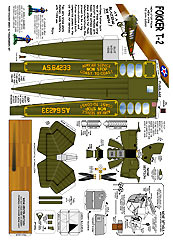



Fokker T2 - $$8.50
The T-2 was an airliner designed in the Netherlands in the early 1920s, but built to the extent of only two examples, both for the United States Army Air Service. It was the largest high-wing cantilever monoplane with fixed tailskid undercarriage Fokker had built. Two different versions. (Only two were built)
Fokker T-2 US Army Air Service-non-stop flight cross country


1923 ... First Cross Country Flight by Lt Oakley Kelly and 1st Lt John McReady USAS was the first cargo aircraft planned and built in the Netherlands with hopes that the airline companies would order it. But the huge plane proved to be a miscalculation and Fokker sold both finished planes to the US Army Air Service for use as cargo planes.
The T-2 would probably have been forgotten if it had not unexpectedly set a world record. On May 2 1923, Lt Oakly Kelly and First Lt John McReady took off from New York on a flight to San Diego and landed after 26 hours and 50 minutes and 38 seconds in the air.
Here's another classic from world class designer, Chauncy Green. He remembers seeing it somewhere as a kid and just never quite got over it. You won't either.
C Greens's T2 is going to be a nice addition to your BETWEEN THE WARS collection. Got a feeling the folks are going to be really happy with that one. Rob Carleen 7/05
Really great work. The artwork is stunning. Your packaging is top notch as well. It really cries "build me". Dan Shiply
Thank you very much, great model...this is one of America's great flights, you make justice to it. Will soon update my page with a special Chapter " Paper Great Planes...Little known"...this model will enhance it!!!!!!! Ciao Gerardo
Chauncey had asked that I do a beta for him on the Fokker.......I think you may have mentioned that on the model's biography page! As always I substituted the rubber o rings for the tires and made the prop to spin. I don't see how the pilots flew the contraption, being offset like it was.......trying to line it up would be a heck of a lineup job .....anyway it is beautiful as always! Col Duckworth
 Hola dude. The new T-2 is a beauty...and a Model 299 in
the wings? I can't wait. ..Muchas Gracias!! Anthony Sanchez
Hola dude. The new T-2 is a beauty...and a Model 299 in
the wings? I can't wait. ..Muchas Gracias!! Anthony Sanchez
I know this guy very well. I was a docent at the National Air and Space Museum from '76 to '85, and the T-2 was in the mezzanine above the entrance along with Amelia Earhart's Lockheed Vega, the Douglas M-2 World Cruiser, Billy Mitchell's Schneider Cup Racer (Curtis R3C2), and Lindbergh's Lockheed Sirius. It would be neat to cut out the side windows and put in the rear control station with a very large circular wheel, as well as a large fuel tank. You might consider models of all of the aircraft in this "explorers" gallery at NASM. Dave Finkleman
The Fokker T-2 with the cockpit details is fantastic. But . . . the color on the wings would be as she hangs in the museum now. In the 1920's, the ground crew types would have had plenty of time to keep her wings painted to regs - the same yellow as you have on the Curtiss J4N "Jenny" (nag-nag-nag!). John
Hi John, Chauncy here. Thanks for your feedback.
In regards to the T-2 wing color; there is not any documentation to show that the T-2's wing was ever painted to reg yellow. Conversely, period photos and documentation from the modifications done prior to the cross-country attempts at McCook Field clearly show and describe the Russian Birch plywood wing skin only being given only a protective coat of "Valspar" varnish. No doubt, had these birds have worked out and the Army bought more, your speculation would be plausible.
Fokker T-2 USAS-non-stop flight cross country flight in 1923

First non-stop trans-US flight, 1923. Piloted by two US Army Air Service
lieutenants, the Fokker T-2 flew non-stop from New York to San Diego, despite
fog, mechanical problems and uncertain navigation in rainstorms.
The Fokker T-2 is famous as the first aircraft to fly coast-to-coast, non-stop. The T-2, a huge airplane with a 79 foot wingspan, was built for the U.S. Army Air Service in 1921 by the Fokker Aircraft Co., also renowned for the fighter aircraft they designed and built for Germany in World War I Two U.S. Army Air Service lieutenants made their first coast-to-coast attempt with the T-2 flying from west to east in an effort to take advantage of the prevailing winds and the higher octane gas in California. They took off from San Diego but fog in the mountain passes turned them back.
On the second try they made it through
the mountains and got as far as the Midwest when the water jacket on their V-12
engine developed a crack. Unwilling to land until they made it to New York,
they began pouring coffee, water and consomme they had into the radiator.
One of the pilots then urinated into a can and poured that in. Out of liquids,
they steered to the handiest field in view...the "brickyard" at the
Indianapolis Speedway. On their third attempt they flew from east to west (Long
Island to San Diego) and were successful in being the first to fly coast-to-coast,
a huge accomplishment for 1923. This flight showed that long distance air travel
was indeed possible and helped pave the way for commercial air travel.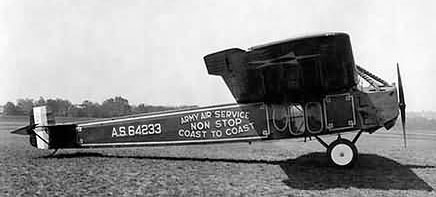
The Fokker T-2 was the first airplane to make a nonstop flight spanning the North American continent. The flight was made under the auspices of the U.S. Army Air Service. Lieutenants Oakley G. Kelly and John A. Macready (see right) took off from Long Island, New York, on May 2, 1923, and landed at Rockwell Field, San Diego, California, on May 3, slightly more than 26 hours and 50 minutes later.
The success of the transcontinental flight can be attributed not only to the preparation and skill of the Air Service, but also to the design of the aircraft. The product of famed Dutch manufacturer Anthony Fokker and his chief designer, Rheinhold Platz, the transcontinental airplane was built at Veere, the Nether-lands, in 1922. Called the Air Service Transport 2, or T-2, it was the fourth in a series of commercial transport designs by the Fokker Company. Two of these airplanes, originally carrying the designation F-IV, were sold to the U.S. Army Air Service in June 1922.
 |
 |
The largest Fokker aircraft up to that time, the T-2 featured a fully cantilevered wooden monoplane wing spanning nearly 82 ft and a fuselage just short of 49 ft long. It was powered by an American-built 420-horsepower Liberty V-12 engine. In its standard configuration, the Fokker had a single pilot's position located in a forward open cockpit to the left side of the engine. The enclosed cabin carried 8 to 10 passengers and their baggage.
Early acceptance trials by the Air Service indicated that the T-2 was capable of carrying heavy loads and could be adapted to make the long-distance flight from coast to coast. Modifications would be required, however. The center section of the wing would have to be reinforced to handle the added weight resulting from the greatly increased fuel supply. The standard 130-gallon fuel tank, located in the leading edge of the wing, was supplemented by a 410-gallon tank in the wing center section and a 185-gallon tank mounted in the fuselage cabin area. Also installed in the cabin was a second set of controls to facilitate control of the airplane when the two-man crew exchanged positions.
 |
 |
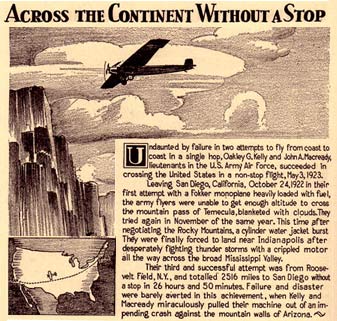 |
|
The first two attempts of the coast-to-coast flight started from San Diego to take advantage of prevailing westerly winds and to use the refined fuel available in California, which had a higher natural octane rating than other fuels. On the first try, fog in the mountain passes 50 miles east of San Diego forced Kelly and Macready to turn back. They remained aloft long enough, however, to test the performance of the airplane under extended flight conditions. The second attempt ended at Fort Benjamin Harrison, near Indianapolis, when a cracked water jacket caused the engine to seize. In the course of the preparations and the two unsuccessful attempts at a west-east crossing, several new engines were installed, and many minor modifications were made to the T-2. All of this work was carried out at the Army Air Service installation at McCook Field, Dayton, Ohio.

The third and successful attempt was made from east to west. Kelly and Macready took off from the combined Roosevelt-Hazelhurst Field on Long Island, New York, at 12:30 p.m., eastern standard time. At takeoff, the airplane had a gross weight of 10,850 lb-only 150 lb less than the T-2's specified limit of 11,000 lb. Lieutenant Kelly was at the controls first, and flew as far as Richmond, Indiana. Kelly then switched places with Lieutenant Macready, who flew the air-craft until midnight, at which time they were approaching the Arkansas River, the 1,188 mi point. They exchanged positions there, again at Santa Rosa, New Mexico, at 6:00 a.m. the following morning, and once more as they crossed the Great Divide at an altitude of 10,200 ft. Macready landed the T-2 in San Diego on May 3 at 12:26 p.m., local time, completing the nonstop transcontinental journey in an official time of 26 hours, 50 minutes, and 38 3/5 seconds. The T-2 had flown 2,470 mi at an average ground speed of 92 mph.

In November 1923, the Air Service offered the T-2 to the Smithsonian Institution, and transferred the airplane in January 1924. The T-2 was fully restored in 1962-1964, and minor refurbishment was done in 1973 in preparation for display of the airplane in the new National Air and Space Museum building in 1976.



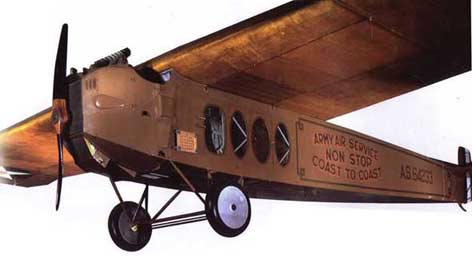

 |
 |
 |
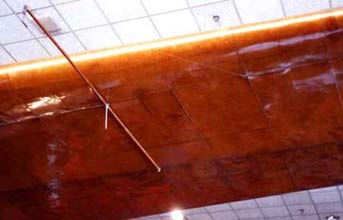 |
These are a few views (above) of the Fokker T-2 airplane on exhibit at the National Air and Space Museum..and below are photos sent in by Col. Duckworth (or maybe they were from Chauncy. :-)
 |
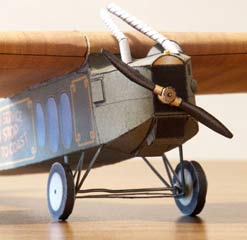 |
 |
 |
|
 |
|

Specifications for the Fokker T2
 |
Crew: One pilot Capacity: 12 passengers Length: 49 ft 3 in Wingspan: 81 ft 4 in Height: 11 ft Wing area: 372 ft² Empty weight: 4,960 lb Gross weight: 7,630 lb Powerplant: 1 × Packard-built Liberty L12 piston engine, 400 hp Performance Maximum speed: 93 mph Range: 2,550 miles Service ceiling: 10,500 ft |





